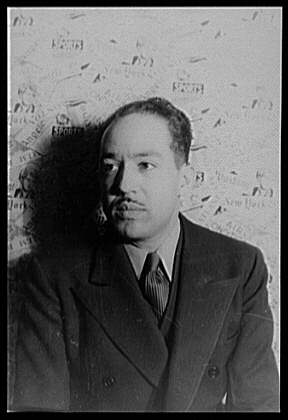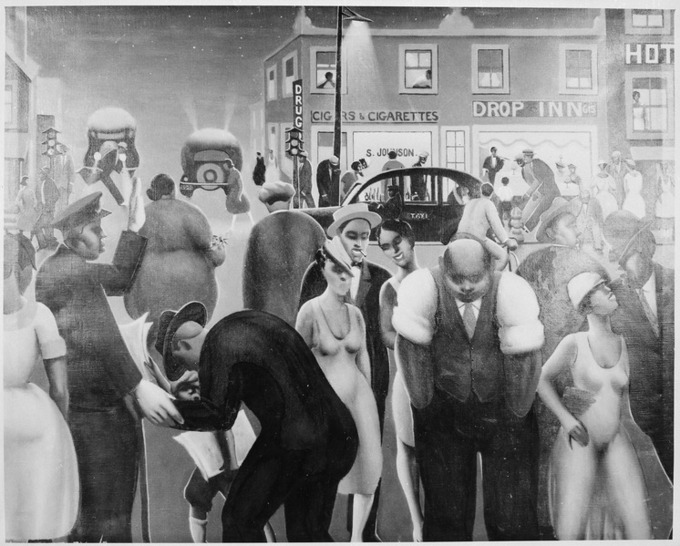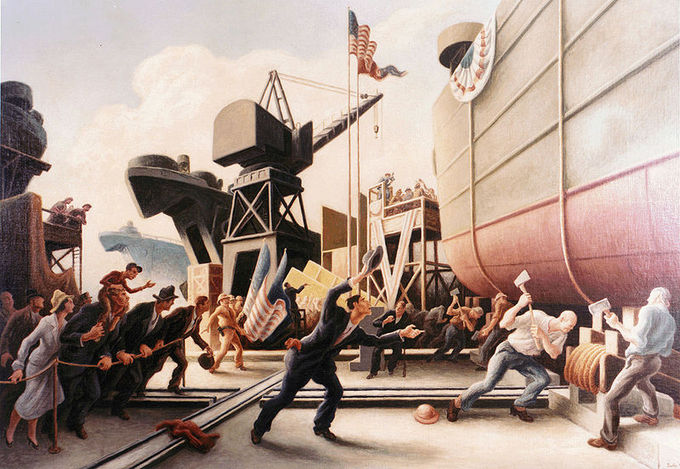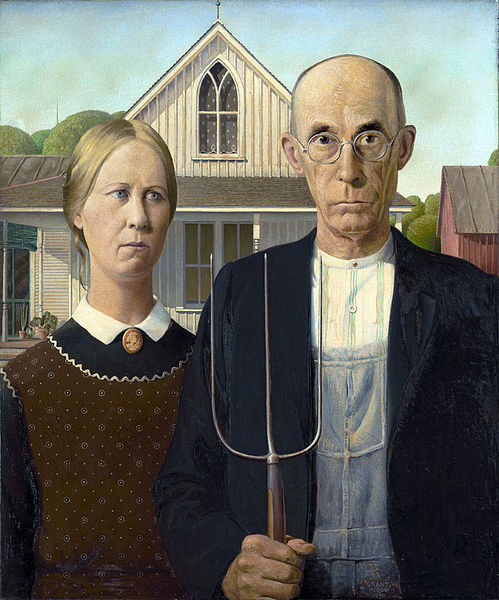29.4: Art in the US during the 1920s and 1930s
- Page ID
- 53133
The Harlem Renaissance
The Harlem Renaissance (1920s–1930s) was an African-American cultural movement known for its proliferation in art, music, and literature.
Learning Objectives
Discuss the characteristics, themes, and contributing factors of the Harlem Renaissance
Key Takeaways
Key Points
- The cultural and political Harlem Renaissance produced visual art, novels, plays, poems, music, and dance that represented the flowering of a distinctive African-American expression.
- Along with the artists, political leaders such as Marcus Garvey founded potent philosophies of black self-determination and unity among black communities in the United States, the Caribbean, and Africa.
- Harlem became an African-American neighborhood in the early 1900s, during the Great Migration in which many African Americans sought a better standard of living and relief from the institutionalized racism in the South.
- While there was no unifying characteristic of the movement, common themes included the influence of slavery, black identity, the effects of institutional racism, and how to convey the experience of modern black life in the urban North.
- Notable visual artists of the movement include Aaron Douglas, Archibald Motley, Charles Henry Alston, and Jacob Lawrence.
Key Terms
- Red Summer: The race riots that occurred in more than three dozen cities in the United States during the summer and early autumn of 1919.
- race riots: Riots caused by racial hatred or dissension. They occurred throughout the 20th century, especially before and during the Civil Rights Movement.
- blackface: A style of theatrical makeup in which a white person blackens their face in order to represent a negro.
Overview
The Harlem Renaissance was a cultural movement in the United States that spanned the 1920s and 1930s. While the zenith of the movement occurred between 1924 and 1929, its ideas have lived on much longer. At the time, it was known as the New Negro Movement, named after the 1925 anthology by Alain Locke.
This cultural and political renaissance produced novels, plays, murals, poems, music, dance, and other artwork that represented the flowering of a distinctive African-American expression. Along with the artists, political leaders such as Marcus Garvey founded potent philosophies of self-determination and unity among black communities in the United States, the Caribbean, and Africa.
At the same time, activists like Hubert Harrison challenged the notion of the renaissance, arguing that the term was largely a white invention that overlooked the continuous stream of creativity that had emerged from the African-American community since 1850.
Harlem’s Background
The district of Harlem had originally developed in the 19th century as an exclusive suburb for the white middle and upper classes. During the enormous influx of European immigrants in the late 19th century, the once exclusive district was abandoned by whites, who moved further north.
Harlem became an African-American neighborhood in the early 1900s, during the Great Migration in which many sought a better standard of living and relief from the institutionalized racism in the South. Others of African descent came from racially stratified communities in the Caribbean, seeking a better life in the U.S. By 1930, 90,000 new arrivals joined the African-Americans already living there, creating a community of nearly 200,000.
Despite the increasing popularity of black culture, virulent white racism continued to affect African-American communities. Race riots and other civil uprisings occurred throughout the U.S. during the Red Summer of 1919, reflecting economic competition over jobs, housing, and social territories.
Characteristics and Themes
What characterized the Harlem Renaissance was an overt racial pride and the developing idea of a new black identity, that through intellect and production of literature, art, and music could challenge the pervading racism and promote progressive politics.
There was no uniting form characterizing the art that emerged, however. It encompassed a wide variety of styles, including Pan-African perspectives; high culture and low culture; traditional music to blues and jazz; traditional and experimental forms in literature, such as modernism; and the new form of jazz poetry.
Some common themes represented during the Harlem Renaissance were the influence of slavery, black identity, the effects of institutional racism, the dilemmas of performing and writing for elite white audiences, and how to convey the experience of modern black life in the urban North.
New authors attracted a great amount of national attention, and the Harlem Renaissance led to more opportunities for blacks to be published by mainstream houses. Some authors who became nationally known were Jean Toomer, Jessie Fauset, Claude McKay, Zora Neale Hurston, James Weldon Johnson, Alain Locke, Eric D. Walrond, and Langston Hughes.

Langston Hughes: Langston Hughes was one of the most well-known writers to emerge from the Harlem Renaissance.
A new way of playing the piano called Harlem Stride was also created during the Renaissance, and jazz musicians like Fats Waller, Duke Ellington, Jelly Roll Morton, and Willie “The Lion” Smith are considered to have laid the foundation for future musicians of their genre.
Visual artists of the time included Charles Alston, Henry Bannarn, Leslie Bolling, Aaron Douglas, Jacob Lawrence, and Archibold Motley.

Black Belt (original painting in color): Archibald Motley is most famous for his colorful chronicling of the African-American experience during the 1920s and 1930s and is considered one of the major contributors to the Harlem Renaissance.
Aaron Douglas
Aaron Douglas was a notable artist of the Harlem Renaissance. After completing his BFA at the University of Nebraska in 1922, Douglas moved to New York City, settling in Harlem. Just a few months after his arrival he began to produce illustrations for both The Crisis and Opportunity, the two most important magazines associated with the Harlem Renaissance.
He also began studying with Winold Reiss, a German artist who had been hired by Alain Locke to illustrate The New Negro. Reiss’ teaching helped Douglas develop the modernist style he would employ for the next decade.
Douglas’ engagement with African and Egyptian design brought him to the attention of W. E. B. Du Bois and Dr. Locke, who were pressing for young African-American artists to express their African heritage and African-American folk culture in their art.
In 1926 Douglas married Alta Sawyer. They lived together in Harlem and for the next several years, opened their home to an important, powerful circle of artists and writers we now call the Harlem Renaissance.
Charles Henry Alston
Charles Henry Alston (November 28, 1907–April 27, 1977) was an African-American painter, sculptor, illustrator, muralist, and teacher who lived and worked in Harlem. Alston was the first African-American supervisor for the Works Progress Administration’s Federal Art Project.
Alston designed and painted murals at the Harlem Hospital and the Golden State Mutual Life Insurance Building. In 1990 Alston’s bust of Martin Luther King, Jr. became the first image of an African-American displayed at the White House.
In the beginning, Charles Alston’s mural work was inspired by the work of Aaron Douglas, Diego Rivera, and José Clemente Orozco, the latter who he met when they did mural work in New York. In 1943 Alston was elected to the board of directors of the National Society of Mural Painters.
He created murals for the Harlem Hospital, Golden State Mutual, American Museum of Natural History, Public School 154, the Bronx Family and Criminal Court, and the Abraham Lincoln High School in Brooklyn, New York.

Modern Medicine: Alston’s mural at the Harlem Hospital is a significant work of the Harlem Renaissance.
Jacob Lawrence
Jacob Lawrence (1917–2000) was an African-American painter known for his portrayal of African-American life. But not only was he a painter, storyteller, and interpreter, he also was an educator. Lawrence referred to his style as dynamic cubism, though by his own account the primary influence was not so much French art as the shapes and colors of Harlem.
He brought the African-American experience to life using blacks and browns juxtaposed with vivid colors. He also taught, and spent 15 years as a professor at the University of Washington.
Lawrence is among the best-known 20th-century African-American painters. He was 23 years old when he gained national recognition with his 60-panel Migration Series, painted on cardboard. The series depicted the Great Migration of African Americans from the rural South to the urban North. A part of this series was featured in a 1941 issue of Fortune Magazine. The collection is now held by two museums.
Lawrence’s works are in the permanent collections of numerous museums, including the Philadelphia Museum of Art, the Museum of Modern Art, the Whitney Museum, the Phillips Collection, Metropolitan Museum of Art, the Brooklyn Museum, and Reynolda House Museum of American Art. He is widely known for his modernist illustrations of everyday life as well as epic narratives of African American history and historical figures.

Jacob Lawrence, Self Portrait: This painting, done in 1977, exemplifies the vivid use of color in his work.
American Regionalist Art
Regionalism refers to a naturalist and realist style of painting that dominated American rural painting in the 1930s.
Learning Objectives
Define the American painting style of Regionalism
Key Takeaways
Key Points
- After World War I, many American artists rejected the modern trends emanating from the Armory Show and European influences such as those from the School of Paris. Instead they chose to adopt academic realism to depict American rural scenes.
- By the 1940s there was a strong debate among the Regionalists and the Social Realists in rural areas, whose work addressed social, economic, and political issues; and the Abstract artists in New York City who embraced Modernism.
- Using a realist approach, the artistic focus of Regionalism was to create scenes of rural life by artists who shunned city life and rapidly developing technological advances.
- Regionalist style was at its height from 1930 to 1935, and is best-known through the so-called Regionalist Triumvirate of Grant Wood in Iowa, Thomas Hart Benton in Missouri, and John Steuart Curry in Kansas.
Key Terms
- social realism: An artistic movement, expressed in the visual and other realist arts that depicts social injustice and economic hardship through unvarnished pictures of life’s struggles that often depict working-class activities as heroic.
- School of Paris: A school of art that represented the importance of Paris as a center of Western art in the early decades of the 20th century, and where a group of artists including Picasso, Chagall, Mondrian, and Matisse created in the styles of Post-Impressionism, Cubism, and Fauvism.
- Armory show: The 1913 International Exhibition of Modern Art that was organized by the Association of American Painters and Sculptors. The exhibition ran in New York City’s 69th Regiment Armory from February 17 until March 15, and became an important event in the history of American art, introducing New Yorkers to modern art.
Overview of American Regionalism
Regionalism, also known as American scene painting, refers to a naturalist style of painting that was prevalent during the 1920s through the 1950s in the United States. After World War I, many American artists rejected the modern trends that emanated from the Armory Show and European influences, choosing instead to adopt an academic realism to depict American rural scenes.
Partly due to the Great Depression, Regionalism became one of the dominant art movements in America in the 1930s (the other being Social Realism). At the time, the United States was still a heavily agricultural nation with a much smaller portion of its population living in industrial cities such as New York City or Chicago.
A debate between abstraction versus realism had been ongoing since the 1913 Armory Show, and this continued throughout the 1930s among Regionalism, Social Realism, and Abstract art. By the 1940s this debate evolved into two camps that were divided geographically and politically:
- The Regionalists and the Social Realists who primarily lived in rural areas and whose work addressed social, economic, and political issues.
- The Abstract artists who primarily lived in New York City and embraced Modernism.
Regionalism’s eventual loss of status in the art world is mainly a result of the ultimate triumph of Abstract expressionism, when Modernist critics gained power in the 1940s.
The Regionalists and the Social Realists
Using a realist approach, Regionalist artists shunned city life and its rapidly developing technological advances to create scenes of rural life. In Grant Wood’s pamphlet Revolt Against the City, published in Iowa City in 1935, he asserts that American artists and buyers of art were no longer looking to Parisian culture for subject matter and style.
Wood wrote that Regional artists interpret the physiography, industry, and psychology of their hometown, and that the competition of these preceding elements creates American culture. He wrote that the lure of the city was gone, and hoped that art of the widely diffused “whole people” would prevail.

The Midnight Ride of Paul Revere: This painting by Grant Wood, done in 1931, exemplifies a typical Regionalist depiction of small-town America.
During the Great Depression of the 1930s, Regionalist art was widely appreciated for its reassuring images of the American heartland. Much of the work conveyed a sense of nationalism and romanticism in depictions of everyday American life.
During the 1930s, these artists documented and depicted American small towns and rural landscapes, as well as cities; the works which stress local and small-town themes are often called American Regionalism, and those depicting urban scenes, with political and social consciousness, are called Social Realism.
Some artists depicted images as a way to return to a simpler time away from industrialization, whereas others sought to make a political statement and lent their art to revolutionary and radical causes.

Cut the Line: This 1944 artwork by Thomas Hart Benton shows the launch of a Tank Landing Ship (LST). Benton is considered by many art critics to be the quintessential American artist of the 20th Century, and during World War II was commissioned by Abbott Laboratories to produce artworks about the Navy.
Regionalist style was at its height from 1930 to 1935, and is best-known through the so-called Regionalist Triumvirate of Grant Wood in Iowa, Thomas Hart Benton in Missouri, and John Steuart Curry in Kansas.
Other artists of the movement include John Rogers Cox, Alexandre Hogue, Dale Nichols, and William S. Schwartz. Many artists involved in the movement studied with or under Benton at the Kansas City Art Institute (KCAI), such as John Stockton de Martelly, Frederic James, and Pat Potucek.

American Gothic: Grant Wood’s best-known work is this 1930 painting, which is also one of the most famous paintings in American art, and one of the few images to reach the status of universally recognized cultural icon, comparable to Leonardo da Vinci’s Mona Lisa and Edvard Munch’s The Scream.
Photography during the Great Depression
During the 1930s and 1940s, photography evolved in terms of its technical possibilities as well as its function as an art form.
Learning Objectives
Describe the evolution of photography from 1930–1945
Key Takeaways
Key Points
- In 1935–1936 both Kodak and Agfa introduced new color film technologies that allowed for the proliferation of color photography for the first time.
- Social realism extended to photography, and depicted social injustice and economic hardship through unvarnished pictures of life’s struggles. Working-class activities were often depicted as heroic.
- Group f/64, led by Ansel Adams, was a group of seven San Francisco photographers who shared a common photographic style characterized by sharp-focused and carefully framed images seen through a particularly Western viewpoint.
- The FSA funded a number of photographers to document the realities of the Depression and who created the iconic images that we still see today.
Key Terms
- Harlem Renaissance: An African-American cultural movement that spanned the 1920s and 1930s and is characterized by a proliferation of music, literature, poetry and dance.
- pictorialism: A school of artistic photography that emphasized using photography to mimic certain styles of contemporary painting, and flourished in the late 19th and early 20th centuries. Images were typically characterized by a soft focus and color or brushstroke manipulation.
- Great Depression: A major economic collapse that lasted from 1929 to 1940 in the United States.
Overview
The period from 1930–1945 in American history is marked by the Great Depression and the outbreak of the second World War. During this time, both photography and sculpture expanded into new realms of artistic expression, heavily influenced by the society and times.
Photography
Photographic technology continued to expand throughout the 20th century. Kodachrome, the first modern integral tripack (or monopack) color film, was introduced by Kodak in 1935, and Agfa’s similarly structured Agfacolor Neu was introduced in 1936. These new technologies allowed for the proliferation of color photography for the first time, and currently available color films still employ a multilayer emulsion and the same principles, most closely resembling Agfa’s product.
Social Realism
Social realism, also known as socio-realism, became an important art movement during the Great Depression in the 1930s. Social realism depicted social and racial injustice, and economic hardship through unvarnished pictures of life’s struggles, and often portrayed working-class activities as heroic.
The movement was largely a style of painting that typically conveyed a message of social or political protest edged with satire; however, it also extended to the art of photography. Prominent photographers at the time included Walker Evans, Dorothea Lange, Margaret Bourke-White, Lewis Hine, Edward Steichen, Gordon Parks, Arthur Rothstein, Marion Post Wolcott, Doris Ulmann, Berenice Abbott, Aaron Siskind, and Russell Lee, among several others.
Each of these artists sought to depict the world–and often the poverty–they saw around them with the realistic portrayal that only photography could provide.
The FSA
The Farm Security Administration, part of the New Deal, was an effort during the Depression to combat American rural poverty. The majority of the program was directed towards rural rehabilitation, but it is also known for funding the work of a number of photographers.
From 1935–1944, the Farm Security Administration employed several photographers to document the effects of the Great Depression on the population of America. The Information Division of the FSA was responsible for providing educational materials and press information to the public.
Under Roy Stryker, the Information Division of the FSA adopted a goal of “introducing America to Americans.” Many of the most famous Depression-era photographers, such as Walker Evans, Dorothea Lange, and Gordon Parks, were fostered by the FSA project.

Migrant Mother: The caption of the image reads: “Destitute pea pickers in California. Mother of seven children. Age thirty-two. Nipomo, California.” Lange’s image of a supposed migrant pea picker, Florence Owens Thompson, and her family has become an icon of resilience in the face of adversity.
Group F/64
Alongside social realism, another approach to photography, referred to as straight photography, was also gaining momentum. Group f/64 is perhaps the most well-known example of this art movement.
Group f/64 was a group of seven, 20th-century San Francisco photographers who shared a common photographic style characterized by sharp-focused and carefully framed images seen through a particularly Western viewpoint. In part, they formed in opposition to the pictorialism movement in photography that had dominated much of the early 20th century, but moreover they wanted to promote a new modernist aesthetic that was based on precisely exposed images of natural forms and found objects.
Photographers involved in the group included Ansel Adams, Imogen Cunningham, John Paul Edwards, Sonya Noskowiak, Henry Swift, Willard Van Dyke, and Edward Weston.
Yosemite Trees with Snow on Branches, by Ansel Adams: Ansel Adams was one of the co-founders of Group f/64, a group of photographers known who shared a common style characterized by sharp-focused and carefully framed images.
- Curation and Revision. Provided by: Boundless.com. License: CC BY-SA: Attribution-ShareAlike

